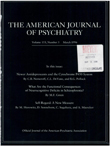Validity of rapid cycling as a course specifier for bipolar disorder
Abstract
OBJECTIVE: This study's aim was to test the validity of rapid cycling, defined by criteria consistent with those proposed in the DSM-IV draft, as a course specifier for bipolar disorder. METHOD: The study was conducted at a university center for affective disorders on patients fulfilling Research Diagnostic Criteria for bipolar disorder. Thirty- seven rapid-cycling patients, i.e., patients with at least four affective episodes during the previous year, were compared with 74 nonrapid-cycling patients on several demographic and clinical variables. All patients were then followed up prospectively for 2-5 years by monthly personal interviews. RESULTS: The rapid-cycling group was significantly older and had a significantly longer illness duration than the nonrapid-cycling group but did not have a significantly higher percentage of women or frequency of current hypothyroidism. During each year of follow-up, the mean number of affective episodes and the percentage of patients with at least four affective episodes were significantly higher among rapid-cycling patients. Rapid-cycling patients with a pole-switching pattern during the year preceding intake were significantly more likely than other rapid-cycling patients to have at least four affective episodes during each of the first 4 years of follow-up. CONCLUSIONS: These findings support the practical usefulness of rapid cycling as a course modifier for bipolar disorder, since it identifies a patient subgroup with a high recurrence rate. The predictive value of the modifier may be enhanced by the requirement of a pole-switching pattern. Since no external (i.e., unrelated to course) validator was found, the idea that rapid cycling represents one extreme of a continuum of episode frequency in bipolar disorder remains viable.
Access content
To read the fulltext, please use one of the options below to sign in or purchase access.- Personal login
- Institutional Login
- Sign in via OpenAthens
- Register for access
-
Please login/register if you wish to pair your device and check access availability.
Not a subscriber?
PsychiatryOnline subscription options offer access to the DSM-5 library, books, journals, CME, and patient resources. This all-in-one virtual library provides psychiatrists and mental health professionals with key resources for diagnosis, treatment, research, and professional development.
Need more help? PsychiatryOnline Customer Service may be reached by emailing [email protected] or by calling 800-368-5777 (in the U.S.) or 703-907-7322 (outside the U.S.).



